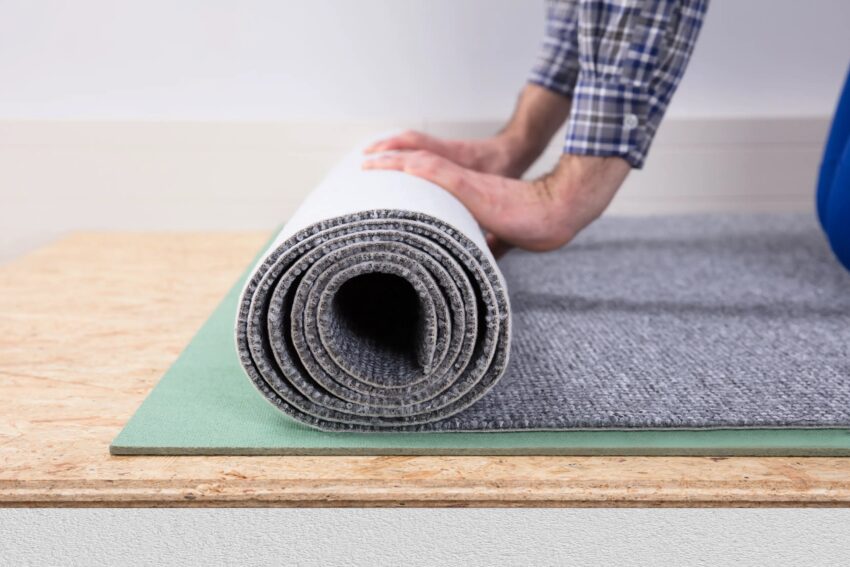The average carpet installation cost in the U.S. is $700 to $2,000, with most carpet materials costing an average of $2.50 per square foot. In this price guide to carpet installation, we’re going over everything you need to know about when to replace your carpet and the factors influencing your cost.
Factors Influencing Carpet Installation Cost
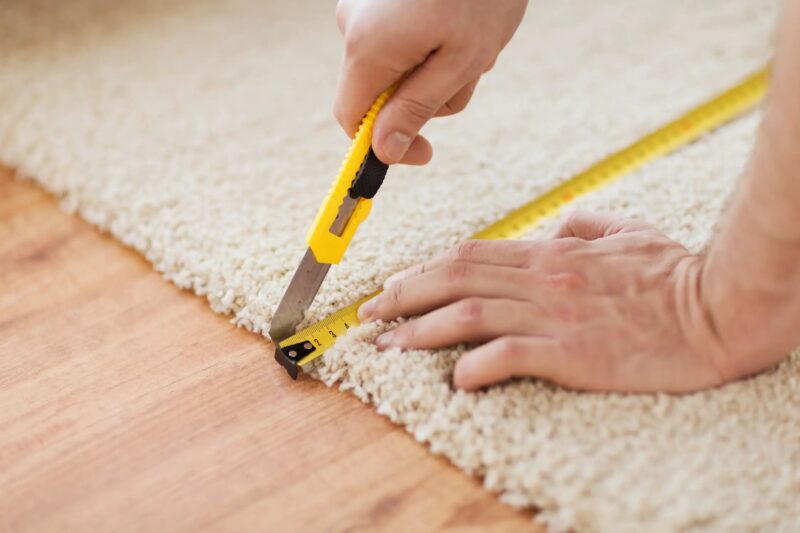
Several factors influence the cost of carpet installation, which ranges from $3 to $10 per square foot.
Material Selection
The material you choose is the most significant factor determining carpet replacement cost. Learn more about the different types of carpets and their prices.
Carpet Type and Price Variations
Carpet is made from several types of materials. The average carpet cost per square foot is $2.50, or about $10 per square yard. The more you pay for the materials, the higher your overall installation costs.
| Carpet material | Best for | Carpet prices per square foot |
| Nylon | High-traffic areas like living rooms | $3.50 |
| Olefin | Low to moderate traffic | $2.00 |
| Polyester | Basements | $2.00 |
| Wool | Low to moderate traffic | $7.50 |
Piles and Patterns
You can also get carpet in different piles and patterns, which will affect the cost of carpet per square foot.
| Pile type | Best for | Average cost per square foot |
| Cut pile | Low traffic areas | $0.60 to $9.00 |
| Loop pile and berber | Heavy traffic areas | $0.50 to $8.00 |
| Cut and loop pile | Moderate traffic areas | $1.00 to $9.00 |
Tall, plush piles are better for bedrooms. Berber is a closed-loop style of carpet pile, often used for commercial settings because it’s resistant to traffic.
Padding Costs and Necessity
Both underlayment and padding are required when installing carpet. Higher-quality padding will increase the lifespan of your carpet, but it costs more. On average, carpet padding costs about $0.75 to $1.25 per square foot.
Labor Costs
Carpet installation cost is greatly affected by labor expenses. Larger carpet installations will take longer, so labor costs will be higher.
Installation Service Fees
Labor costs vary depending on your region, but they typically range from $0.50 to $1.00 per square foot. Some flooring companies include the cost of installation in the price of their carpet.
Duration and Complexity
Other factors that affect labor costs include regional labor market prices and the complexity of the installation. It’s also important to remember that carpet replacement costs don’t always include tearing out old carpet or repairing your floor.
Additional Carpet Replacement & Installation Costs & Considerations
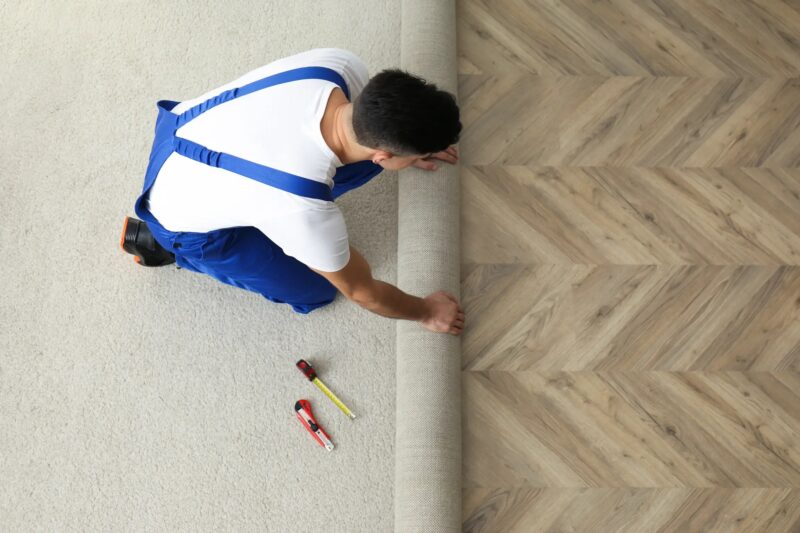
Additional costs and considerations may also influence the carpet price per square foot.
Carpet Removal and Disposal
Some carpet installers include removal and disposal in their installation quotes. However, it’s important to make sure, especially when comparing quotes or DIYing carpet installation.
If you’re doing it yourself, take your time and labor into account when calculating the cost of carpet removal and disposal. You’ll also need a truck to haul the old carpet away.
If your carpet still has some life left in it, junk removal companies may pick it up for free. You can also avoid disposal fees by advertising it for free pickup.
In many municipalities, carpet can be recycled to keep it out of landfills. Contact your waste management company or local recycling business to learn more.
Floor Preparation
You may also incur extra expenses preparing your floor for new carpet installation. Before laying new carpet, it’s a great time to address squeaks in your floor or tighten up any loose or spongy areas.
Other problems that can be addressed at this time include floor leveling and cleaning. If your subfloor has foul odors, consider painting it with KILZ to prevent bad smells from seeping through your new carpet.
Carpet Installation Estimates by Room Size
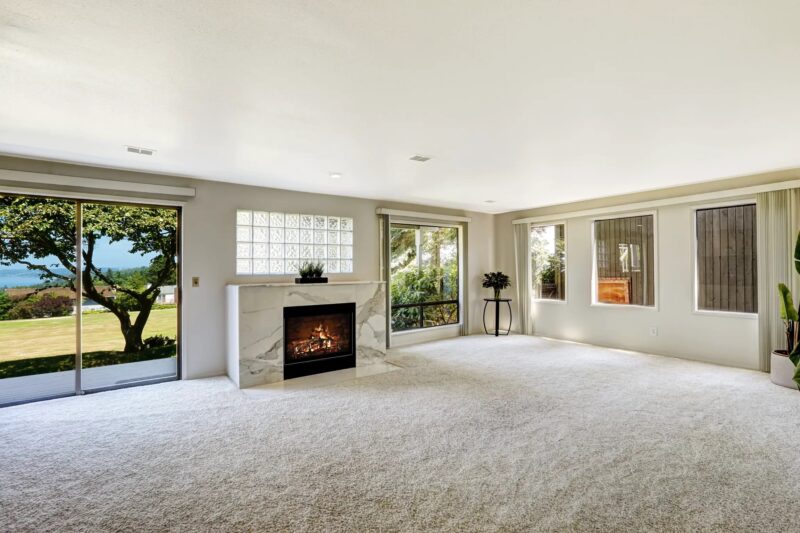
Obviously, the more carpet you have to install, the higher the cost to replace the carpet. Take a look at the average cost of carpeting a room.
Small Rooms and Areas
The shape and size of your room influence carpet installation cost. Small rooms are usually less complex, making installation easier and quicker.
Here are some typical costs associated with standard room sizes:
| Room size | Square feet | Carpet installation cost range |
| 10 x 10 | 100 | $300 to $1,000 |
| 10 x 15 | 150 | $450 to $1,500 |
| 10 x 20 | 200 | $600 to $2,000 |
Expansive Rooms
Large, expansive rooms require much more material and may entail intricate installations, which increases the project’s cost. However, buying in bulk can reduce the cost of carpet installation.
- The average cost to carpet 1000 sq ft is about $1,800 to $7,500, depending on the type of carpet and padding you choose.
- For a 2,000-square-foot home, the average carpet installation cost is about $3,500 to $15,000.
Intricate layouts and custom cuts that require a lot of cutting can increase the time it takes to install your carpet, resulting in higher installation costs. The price of custom cuts varies depending on the project’s complexity and how long it takes.
DIY Vs. Professional Carpet Installation Costs
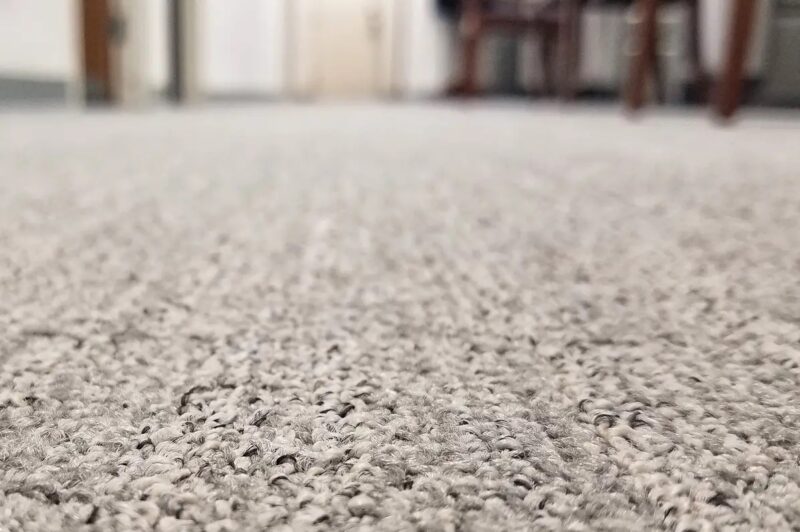
Many homeowners tackle the job of DIY carpet installation and achieve excellent results. But for others, it’s worth it to hire a professional.
DIY Ventures
DIY carpet installation requires the right tools and equipment, but it’s a good way to save money if you’re budget is tight. If you install carpet in your whole house, you can save thousands of dollars with DIY carpet installation.
The most expensive equipment is a power carpet stretcher. Purchasing one costs about $500, but you can rent them for about $35 per day.
If you only install carpet in one small room, purchasing all the tools may not be worth it. Another drawback of DIY carpet installation is that it can be difficult to avoid problems like buckling or noticeable seams.
Engaging Professional Installers
Hiring professional installers ensures that you get a quality installation. Professional installers know how to properly stretch, cut, and seam the carpet to avoid issues like wrinkles and ripples, which can lead to early wear and tear.
Having your carpet professionally installed doesn’t cost much more, and for many homeowners, it’s not worth the hassle to deal with it themselves.
Tips to Minimize Carpet Installation Costs
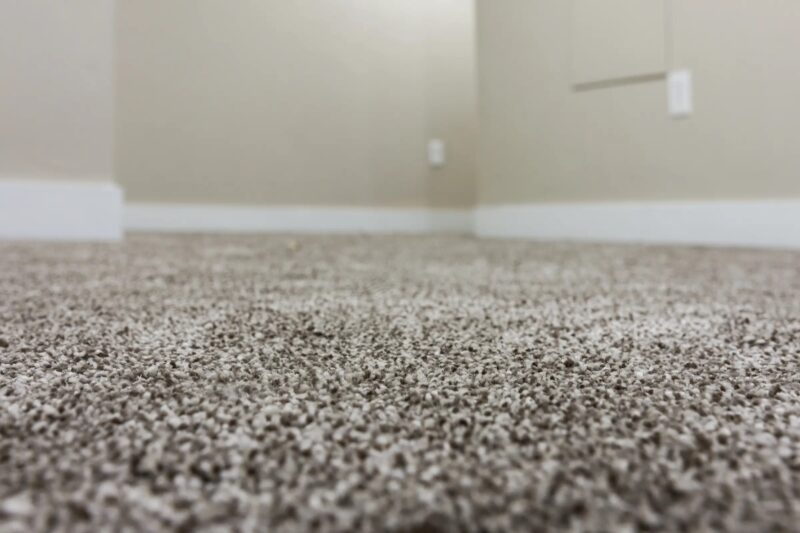
Follow these tips to save money on carpet installation.
Bulk Buying and Bargain Hunting
If you have a large project, it’s worth shopping around and asking for bulk discounts. Get multiple quotes and compare prices between various carpet vendors in your area.
Off-Season Shopping
The best time to buy carpet is December and January, which is when retailers slash their prices by up to 25%. While other people are spending their money on Christmas, you can use seasonal carpet sales to save money.
Scheduling During Non-Peak Periods
Be sure to ask about discounts for scheduling carpet installation during off-peak times. One of the best times of year to have carpet installed is May and June because most people are focusing their efforts on their yards, gardens, and other outdoor activities.
Preparing the Space
You can save money by removing and disposing of the carpet yourself. DIY carpet removal can save you about $1.00 to $1.50 per square foot.
When Should You Replace Your Carpet?
Carpet can last anywhere from 5 to 15 years, depending on the quality and the amount of wear and tear it receives. Under most conditions, carpet will start showing its age after about 10 years, but you may need to replace it even sooner.
Wear and Tear Assessment
How do you know when your carpet needs to be replaced? It may be obvious if you’ve experienced flooding or water damage, but it’s not always easy to know when your carpet is ready for replacement.
Identifying Stains and Irremovable Spots
Even though most carpet stains can be removed using special products and cleaning tools, it’s natural to have increased amounts of carpet staining over time.
If the number of stains in your carpet makes it hard to tell what the original carpet looked like, and you can’t get them out even with professional help, it’s time to replace it.
Acknowledging Worn and Threadbare Areas
Worn areas in your carpet, especially in high-traffic areas, indicate that your carpet needs replacing. Worn areas are often matted, or what’s more, the carpet pile may be missing altogether.
When carpet gets old, it starts to break down faster because the materials deteriorate. Old carpets also collect allergens, and you may notice that you or members of your family are experiencing allergy symptoms.
Decor and Aesthetics Enhancement
Many people replace carpets when they are renovating or redecorating. If it’s time for a style or theme upgrade, you may want to replace your carpet.
Style and Theme Upgrade
Updating the look of your home with new carpet is a great way to make your living space more comfortable. If you’re redecorating, you may want a new color or pattern to go with the rest of the room’s theme.
Comfort and Feel Enhancements
One of the best reasons to get new carpeting is that it will make your home more comfortable. New carpet feels cozier, and it can change the entire atmosphere of your living space.
The Benefits of New Carpeting
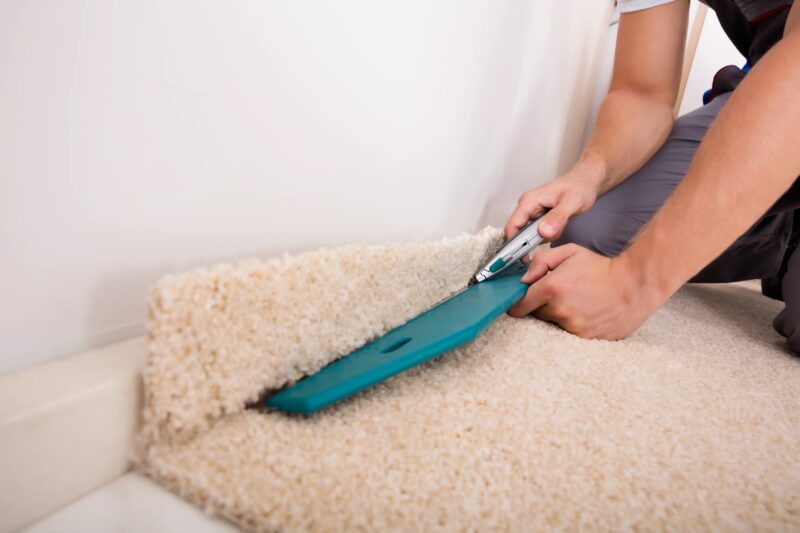
New carpeting can completely transform your living spaces and even increase the resale value of your home. It can also alleviate problems associated with old carpets, like allergies and foul odors.
If you’re thinking about replacing your carpet, consider these benefits.
Aesthetic Enhancement
Simply put, new carpet just looks better than old, worn-out carpet. The color and design of your home’s carpeting can impact the visual appeal of your rooms.
Color and Design Impact
Modern luxury carpets have colors and designs that can brighten any space and add depth and light to your room. Finding the right color of carpet to match the rest of your home’s furnishings can create harmony and improve the atmosphere.
Spatial Perception
Depending on the color and style you choose, carpet can make a room seem more spacious or feel warmer. For example, a soft-colored carpet can reflect light and create the illusion of more space.
Functional Benefits
Carpet does more than just feel good on your feet. It has several functional benefits that make your home safer and more comfortable in other ways.
Insulation and Energy Efficiency
Cold floors can make your entire home seem chilly, and adding carpet is a good way to make your home more comfortable in the winter. Some carpets even have an R-value rating.
Noise Reduction
Reduced noise is another great reason to get new carpeting. If kids running through the house sound like a herd of elephants, consider new carpeting with thick padding.
Frequently Asked Questions About Carpet Installation Costs
What is the lifespan of a newly installed carpet?
Carpet can last anywhere from 5 to 15 years, depending on the quality of carpet and how much wear and tear it gets. Some carpet fibers are made to withstand more traffic, so they’re often used in busy areas like living rooms.
How significant is the impact of carpet type on overall installation costs?
The type of carpet is one of the most significant price determiners of carpet installation. Natural fibers like wool are more expensive than synthetic carpets, such as nylon or olefin. The price difference between high-end and low-quality carpet can vary by up to $8 per square foot.
Is DIY carpet installation a realistic money-saving approach?
You can save hundreds of dollars by installing carpet yourself, but you’ll need to purchase some tools and equipment. If you don’t know what you’re doing, however, you could end up with a bad installation that could result in costly repairs.
Can old carpet padding be reused for new installations?
Old carpet padding contains dust, allergens, and odors, so reusing it is not recommended. Unless the pad is quite new, it should be replaced.
How to maintain the carpet post-installation to ensure durability?
Regular vacuuming extends the lifespan of your carpet. Dirt and debris trapped in the piles wear on the fibers, breaking them down. In high-traffic areas, you should vacuum your carpet two to three times per week, even if it doesn’t look dirty. It’s also important to clean spills immediately.

